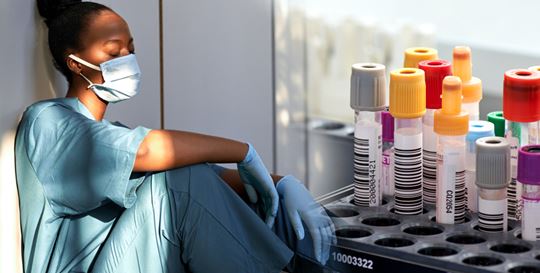*Each cubitainer weighs a maximum of 115 g plus another 3 g for the cap. Total plastic weight per cute is ~118 g, meaning a savings on plastic waste of 2 kg per cubitainer of concentrate with the cap.
† For a 500 test per day lab, shipping costs are reduced from ~$1,050/year to $75/year—a savings of ~95%.
Beckman Coulter is a distributor of RR Mechatronics products. RPI water purification system is manufactured by Life
Science business of Merck KGaA, Darmstadt, Germany. The Life Science business of Merck KGaA, Darmstadt, Germany operates as MilliporeSigma in the U.S. and Canada. Not all products are available in all countries.
Product availability and regulatory status depend on country registration per applicable regulations.
REFERENCES:
1. SUSTAINABILITY AT DANAHER. Danaher. 2022. Accessed March 23, 2023. https://www.danaher.com/sustainability
2. Strengthening Clinical Laboratories. CDC | Division of Laboratory Systems. November 15, 2018. Accessed March 23, 2023. https://www.cdc.gov/csels/dls/strengthening-clinical-labs.html
3. Krause M, Gautam K, Gazda MA, Niraula A. Reducing plastic waste in the lab. Chemistry World. April 30, 2020. Accessed March 23, 2023. https://www.chemistryworld.com/opinion/reducing-plastic-waste-in-the-lab/4011550.article
4. Karliner J, Slotterback S. Health Care’s Climate Footprint: How the Health Sector Contributes to the Global Climate Crisis and Opportunities For Action. Health Care Without Harm; 2019.
5. Dzau VJ, Levine R, Barrett G, Witty A. Decarbonizing the U.S. health sector - A call to action. N Engl J Med. 2021;385(23):2117-2119. doi:10.1056/NEJMp2115675
6. Lederman N. Concentrated Beer? Cutting Liquid before Shipping Also Cuts Its Carbon Footprint . Scientific American. July 1, 2021. Accessed March 23, 2023. https://www.scientificamerican.com/article/concentrated-beer-cutting-liquid-before-shipping-also-cuts-its-carbon-footprint/
7. Haldane J. On cyanmethaemoglobin and photomethaemoglobin. J Physiol (Lond). 1900;25(3):230-232. doi:10.1113/jphysiol.1900.sp000792
8. Thompson T. Hazardous Waste Management in the Laboratory. Lab Manager. March 24, 2022. Accessed March 24, 2023. https://www.labmanager.com/lab-health-and-safety/hazardous-waste-management-in-the-laboratory-27802
9. Formaldehyde. National Institutes of Environmental Health Science. January 23, 2023. Accessed March 24, 2023. https://www.niehs.nih.gov/health/topics/agents/formaldehyde/index.cfm
10. Baranowska I, Wojciechowska I, Solarz N, Krutysza E. Determination of preservatives in cosmetics, cleaning agents and pharmaceuticals using fast liquid chromatography. J Chromatogr Sci. 2014;52(1):88-94. doi:10.1093/chromsci/bms210
11. A REVIEW ON DETERMINATION OF PRESERVATIVES IN FOOD STUFFS BY DIFFERENT ANALYTICAL METHODS | PharmaTutor. Accessed March 24, 2023. https://www.pharmatutor.org/articles/review-on-determination-preservatives-food-stuffs-different-analytical-methods
12. Deforce E. Sustainable Plastics Use in the Laboratory. Lab Manager. Published online August 9, 2021.
13. Urbina MA, Watts AJR, Reardon EE. Environment: Labs should cut plastic waste too. Nature. 2015;528(7583):479. doi:10.1038/528479c
14. Bistulfi G. Reduce, reuse and recycle lab waste. Nature. 2013;502(7470):170-170. doi:10.1038/502170a
15. Cornwall W. The plastic eaters. Science. 2021;373(6550):36-39. doi:10.1126/science.373.6550.36
Social Media

 English
English





